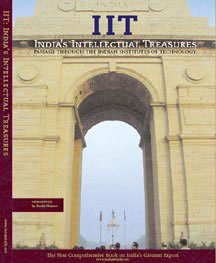|
Suvarna Rajguru and Ranjan Pant. 128 pages. Indus Media, 2003. $60. The authors say they felt there was “a strong need for a comprehensive publication” that would showcase the “historical, cultural background and development” of these institutions for the Indian Diaspora and the IIT alumnus in particular to cherish. The notion that industrial development was possible only by training high level technocrats, in new, freshly created technical institutions for post independent India, propelled Jawaharlal Nehru to build the IITs.
The first IIT was established in Kharagpur in 1951, the site chosen to honor the spirit of the lost political prisoners fighting for India’s freedom in the near by Hijli jail. According to the authors, IIT Kharagpur therefore symbolizes not just technical brilliance but the pride and honor of India in the face of Britain’s legacy of death and destruction. The next four IITs, Bombay, Chennai, Kanpur and Delhi were built by financial and other assistance from UNESCO, USSR, West Germany, USA and Britain and the influences can be seen partly in their unique curriculum and partly in construction. The last two created in 1994 and 2001 at Guwahati and Roorkee, are the creation of the now self reliant central government. Life was not very rosy when the first graduates started emerging from the hallowed portals. Three reviews in 1986, 1995 and 2000 brought home the realization that while the 27,000 engineers who exited these state of the art institutes became trailblazers worldwide, they had failed to meet the needs of the nation’s industry. Several alumni had departed to foreign shores for higher studies and not returned, so India was left struggling with a lagging rural economy. What also stood out was the fact that while the revered, highly experienced older faculty was retiring, there were not many worthy heirs and insufficient support to fund research programs, raise pay scales or even get consultants or professors from outside, and it affected the institutions adversely. While many consider the IITs to be at par with MIT as far as the undergrad programs go, they are considered nowhere near Ivy League standard for postgraduate work. On being reminded that the motto at IIT Kharagpur read “Dedicated to the service of the Nation,” an alumni quipped, “Which Nation?” an biting hreference to the exodus of the Indian technocrats to the U.S. Talking about their alma mater seems to have struck a deep chord within the 35,000 strong IIT alumni community in the United States. The book captures the outpouring of nostalgia and memories and the authors have made a conscious effort to portray the flip side of being an IITian. From studying day and night to the sounds of loud music, the tough competition not just to get in but to survive, lousy food, walking on the dark side with games of Russian roulettes and high stakes, the alumni recall sex, drugs, rock and roll at the Mood Indigo Festivals, attempted suicides and breakdowns. The IIT fraternity also formed “close bonds of friendship that resulted from mutual struggles, competition and commiseration.” An IITian knew the only religion and citizenship that mattered was being an IITian. The $30 billion joint assets and the glorious success that many IITians have savored in the United States is only because of the “fundamentals learnt in IIT,” according to the alumni interviewed. It took the authors two years of extensive research, collaborations with two historians(one of whom did his PhD dissertation on the IITs,) pouring through 50 years of India’s annual reports on education, visits to all the seven campuses, extensive interviews with academia and faculty at IIT and several students and alumni to create this book. This book pinpoints the vital statistics, captures the essence of these institutes to whet the nostalgic appetite of any IITian. It is an intriguing read even for someone not from these techno jewels in India’s crown, a succulent appetizer, and sets the tone for more in-depth books as the main course to follow. |
Book Review

